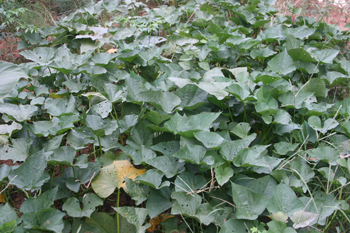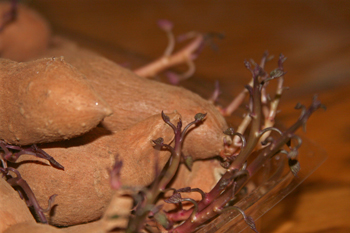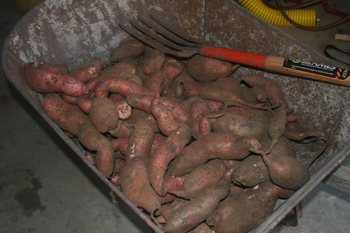 Sweet potato foliage. Photo by Malgorzata Florkowska.
Sweet potato foliage. Photo by Malgorzata Florkowska.Georgia is the perfect place to grow sweet potatoes (Ipomea batatas). Sweet potatoes are considered a long season crop and Georgia's long, hot summers allow them to grow and mature well here. You might consider adding sweet potatoes to the crops you plan on growing in your garden.
The sweet potato is a Native American plant. It is high in calcium, potassium, and vitamins A (which helps prevent night blindness) and C. Also, it is rich in dietary fiber and has small amounts of iron. Sweet potatoes are a healthier alternative to white potatoes, which have a high glycemic index. This means that starch from a white potato is quickly metabolized, leading to a rapid increase in blood sugar. Sweet potato starches are metabolized at a slower rate.
Varieties
There are several sweet potato varieties suitable for growing in Georgia.
Beauregard – This variety is found quite often in garden centers. It shows some disease resistance and produces a high yield. It has a light rose skin and a deep orange flesh. It matures in 105 days.
Centennial – Tolerates clay soil, is disease resistant and matures in 90 days.
Jewel – Produces a high yield and bakes well. Matures in 120 days.
Porto Rico – Matures in 110 days. This is an old “bunch” variety that creates compact vines with big yields. It bakes well.
Yellow Jersey – An old fashioned potato with yellow skin and white flesh. Matures in 100 days.
Soil Preparation, Culture and Fertilization
Sweet potatoes are warm-weather plants. The soil temperature should reach 70 °F before they can be planted in the garden. This can occur in mid-April in south Georgia and the first part of May in the mid- to northern part of the state. They prefer a well-drained loamy to sandy soil that receives 8 to 10 hours of sunlight per day. If your soil contains clay, add some aged compost or other organic amendment to the planting bed to improve drainage. Sweet potatoes grown in unamended clay soils are usually small.
 Sweet potato slips. Photo by Malgorzata Florkowska.
Sweet potato slips. Photo by Malgorzata Florkowska.Sweet potatoes are produced from plants called “slips,” which are small rooted pieces of tuberous root. Slips are produced from the roots of the previous season's crop. Most gardeners prefer to plant slips bought from garden centers because they are most likely to be disease resistant and because sweet potato seeds can be difficult to obtain and get started.
Space the slips 3 ft apart to allow room for the vines to expand. Sweet potatoes do best in a slightly acidic soil with a pH range of 6.0–6.5. Be careful with fertilization. Overfertilized sweet potato plants produce just foliage. Base the fertilizer application on the results of a soil test. In the absence of a soil test, apply 5-10-10 fertilizer at 30 lb per 1,000 square feet. Next, sidedress 4 lb of 5-10-10 per 100 ft of row just before the vines cover the row. Water the plants thoroughly during the late evening or in the early morning to allow the leaves to dry off during the day. Sweet potatoes need at least 1 inch of water per week to grow well. Watering is especially important during the transplant, establishment and root development period. Stop watering the sweet potatoes three to four weeks before harvest to prevent tubers from splitting. Control weeds, especially before the plants cover the row.
Harvest, Storage and Use
 Sweet potatoes after harvest. Photo by Robert Westerfield.
Sweet potatoes after harvest. Photo by Robert Westerfield.Sweet potatoes should be ready to harvest in about 90–120 days after planting. The tops will begin to die back as it gets close to harvest time. They should be harvested before the first frost. Cool soil reduces their quality and storage life. Sweet potato skin is very thin, so freshly dug roots need to be handled gently. After harvest, air dry sweet potatoes for several days in a shady location at temperatures of 80–85 °F. Next, move the potatoes to a final storage area, such as your kitchen, where temperatures do not fall below 55 °F. At this temperature, potatoes can be stored for up to 6 months. Check them for decay frequently and remove any affected potatoes so the decay will not spread.
Sweet potatoes can be grilled, baked, cooked or microwaved whole and make a healthy substitute for white potatoes. Candied sweet potato is a popular fall side dish made of sweet potatoes, brown sugar, orange juice, marshmallows and maple syrup. Sweet potatoes can also be made into a casserole and baked with a brown sugar and pecan topping. Even sweet potato fries have become popular.
Potential Problems
Wireworm and root-knot nematodes seem to be the biggest problems for home gardeners. However, many insect and disease problems can be avoided by choosing disease resistant varieties and using sound cultural gardening practices. Crop rotation with a vegetable in another family can help with nematode and soil disease prevention.
Weeds are perhaps the biggest issue when growing sweet potatoes as the vines spread rapidly over the garden area. The use of mulch and possibly a pre-emergent herbicide will help keep weeds under control. It is difficult to use cultivation around the plants once they begin to spread out.
Status and Revision History
Published on Mar 16, 2012
Published with Full Review on Mar 28, 2017
Published with Full Review on Jun 24, 2022


























































